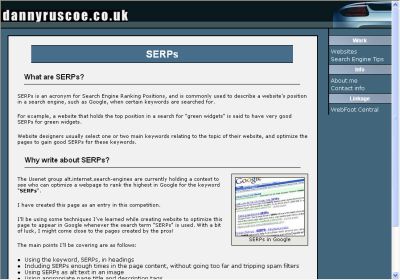Sunday, January 18, 2004
SERPs Competition Update

By now there are 18 entries to the SEO SERPs competition already. It’s all about getting the best ranking for “SERPs"*. And the only rules are that the page must be new. Other than that, you can use any approach you like. Also see the current newsgroup thread for the discussion.
*I came up with the term “SERPs” instead of a previously suggested “sex kitten” (too adult for a competition of this kind).
Currently Leading
On the participating pages you can see the keyword “SERPs” flying all around (in title, headings, normal text). And I’m sure people are also linking to their contest page from one of a high-ranking site under their control.

SERPs all around on a XHTML1 Strict page
Guess what – two sites already creeped into the Google Top 10. One of them – current leader, at #3 for “SERPs"** – is a blog of its own, which even got a “serps” sub-domain***. The PageRank for the leading entry is zero at the moment.
“SERPs are our friends.
I fell in love with a serp.
Waiter there’s a serp in my soup.”
– http://serps.blogspot.com/2004_01_01_serps_archive.html
Another special mention for wackiness goes to the SERPs entry by the Rinky Dink corporation.
**I’m on #20 with my SERPs entry.
***There’s also a new top-level domain joining the competition: www.serps.info
Google AdSense Coming to Email?
Google Advertising may be seen in future emails, according to some insiders [Forbes and others via Reuters]. AdSense are context relevant, which is good because it’s non-spammy (it actually helps the reader), but two things might cause trouble in the world of electronic mail.
The AdSense advertisement blocks are supposed to show up dynamically. This is HTML technology, and many newsletters are plain ASCII text. And even if the newsletter is HTML, the current technology is based on inline frames, which look a lot like the technology used by a certain type of email virus*.
Now I wonder if spammers will be the first to make use of this service large-scale? That wouldn’t be too good for the image Google Inc. has in public.
*In older versions of Outlook Express it was enough to send the wrong content-type within this “iframe” to confuse the email client and possibly harm the system – basically, the code told the computer “I’m a video, use the permissions you allow for displaying video without asking the user”, but at the same time exploited a bug that caused Internet Explorer rendering to believe “You look like a video judging from the extension, so you get video permissions on this machine right-away, but I will treat you according to the content-type the server sends, so you are an executable”.
>> More posts
Advertisement
This site unofficially covers Google™ and more with some rights reserved. Join our forum!
